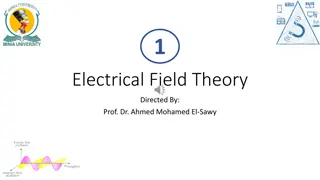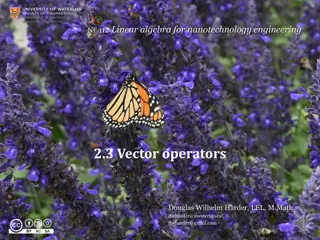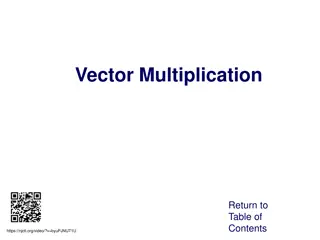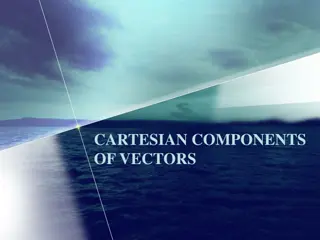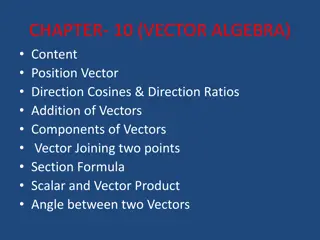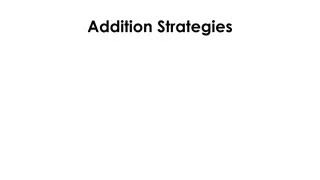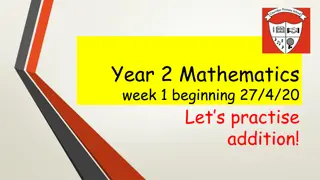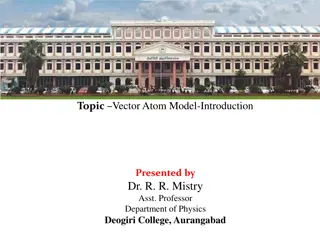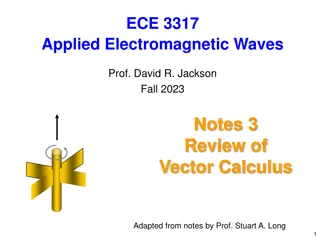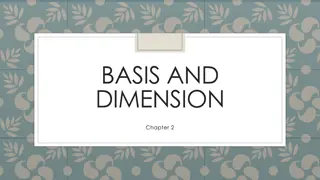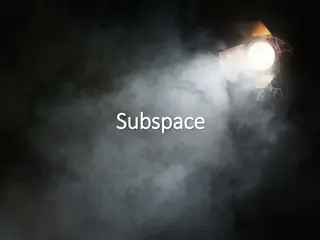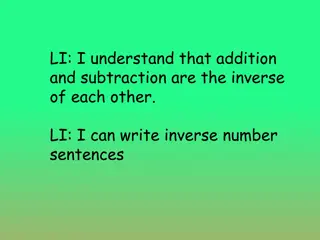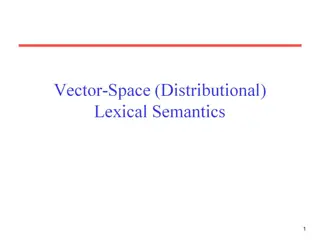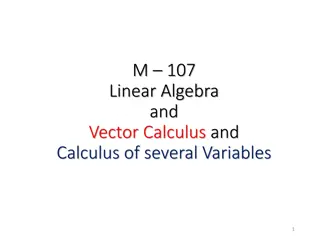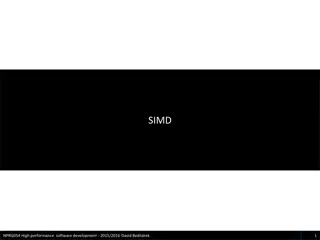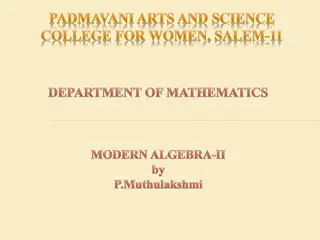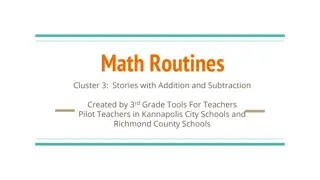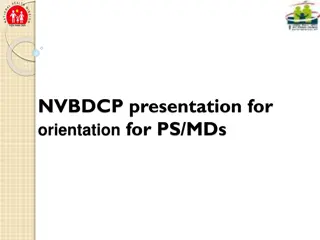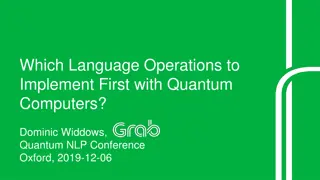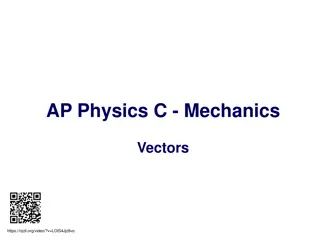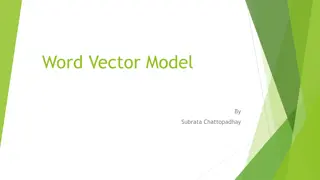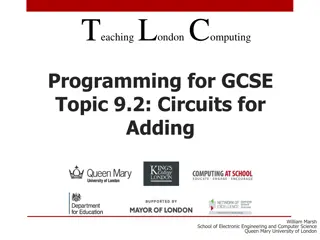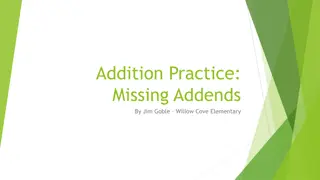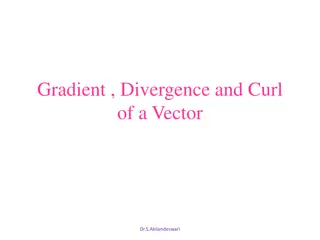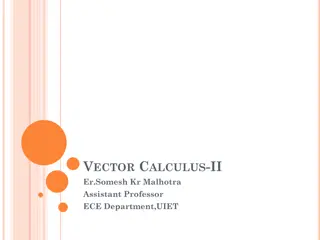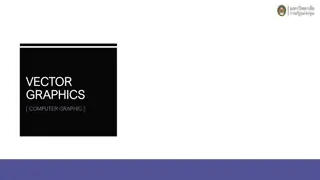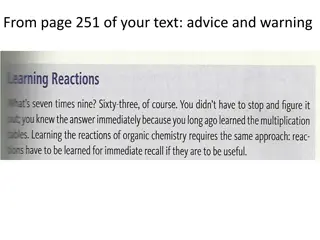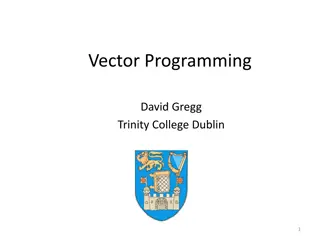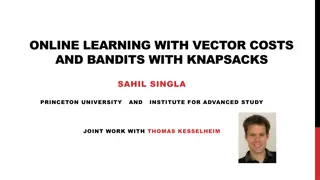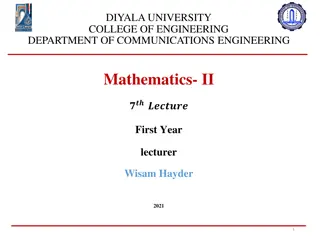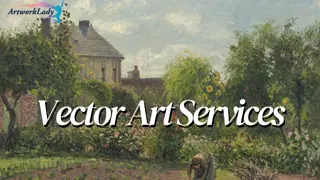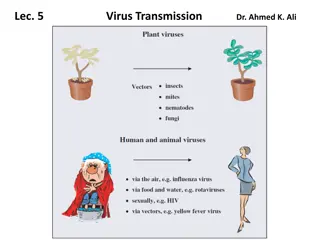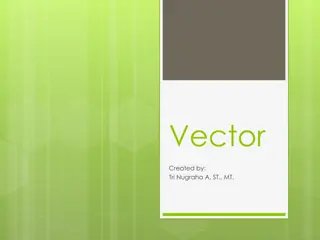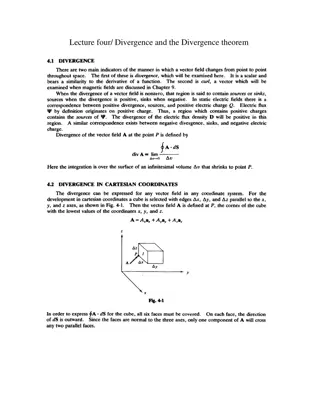Electrical Field Theory: Vector Analysis in Different Coordinate Systems
Explore the principles of Vector Analysis in Cartesian, Cylindrical, and Spherical coordinate systems as applied to Electrical Field Theory. Learn how to calculate differential lengths, areas, and volumes, and solve practical examples under the guidance of Prof. Dr. Ahmed Mohamed El-Sawy.
5 views • 10 slides
Vector Operations in Linear Algebra
Explore the world of vector operations in linear algebra through this detailed presentation. Learn about vector addition, scalar multiplication, field operations, and more. Gain insights into the notation of Fn and the significance of scalar multiplication and vector addition in linear algebra. Whet
8 views • 9 slides
Normed Vector Spaces for Nanotechnology Engineering
Introduction to normed vector spaces, focusing on defining norms for vectors in finite-dimensional spaces, exploring different ways to measure vector length, and understanding the concept of unit vectors and norm properties. This topic equips readers with the ability to calculate vector norms, norma
0 views • 9 slides
Vector Multiplication
Learn about vector multiplication, unit vectors, magnitude calculations, scalar dot products, cross products, and angle determinations between vectors. Explore video explanations and visual representations for a comprehensive understanding of vector mathematics concepts.
0 views • 11 slides
Introduction to Cartesian Components of Vectors in Two-Dimensional Space
Exploring Cartesian components of vectors in a two-dimensional coordinate frame using unit vectors i and j. Learn how to express vectors, add them using the triangle law, use column vector notation, and find resultant vectors. Understand position vectors in terms of coordinates. Examples and diagram
0 views • 16 slides
Vector Algebra and Its Applications
Explore the fundamentals of vector algebra, including position vectors, direction cosines, direction ratios, vector addition, scalar product, vector product, and more. Learn about the dot product, cross product, and the angle between two vectors. Visual aids and examples help clarify key concepts in
0 views • 18 slides
Effective Addition Strategies for Mathematical Problems
Explore various addition strategies such as adding up in chunks, using place value, compensation, making a ten/bridging through ten, and leveraging near doubles. These methods provide a practical approach to solving addition problems efficiently and accurately by breaking down numbers and manipulati
0 views • 33 slides
Year 2 Mathematics Week 1: Addition Practice
In Year 2 Mathematics Week 1, students will be practicing addition of two-digit numbers using methods like partitioning into tens and ones and the expanded column method. Parents are encouraged to help and show different methods to their children, such as drawing dienes or using squared paper for la
1 views • 10 slides
Exploring the Vector Atom Model in Quantum Physics
Delve into the Vector Atom Model as presented by Dr. R. R. Mistry, discussing the quantum numbers, coupling, exclusion principles, and effects like Zeeman and Stark. Learn how this model explains complex atomic spectra and spatial quantization, offering a deeper understanding of atomic structures.
0 views • 11 slides
Overview of Vector Calculus for ECE 3317 Course
This overview provides a brief explanation of vector calculus concepts essential for the ECE 3317 course on Applied Electromagnetic Waves. It covers del operator, gradient, divergence, curl, vector Laplacian, vector identities, and their applications in electromagnetic field theory.
0 views • 24 slides
Basis and Dimension in Linear Algebra
Basis and dimension are fundamental concepts in linear algebra. A basis is a set of vectors in a vector space that allows us to represent any vector by multiplying and adding the basis vectors. The dimension of a vector space is the number of elements in its basis. Linear independence, spanning sets
0 views • 13 slides
Introduction to Differential Evolution Metaheuristic Algorithm
Differential Evolution (DE) is a vector-based metaheuristic algorithm known for its good convergence properties. Developed by Storn and Price in the late 1990s, DE operates on real numbers as solution strings, making encoding and decoding unnecessary. This algorithm utilizes vectors for mutation and
8 views • 18 slides
Parallelism and Vector Instructions in CMPT 295
Delve into the world of parallelism and vector instructions in CMPT 295 as you explore fixed-length vector intrinsics, RISC-V concepts, computer programming fundamentals, processor execution processes, scalar and vector loops, and more. Discover the intricacies of memory, data arrays, structs, integ
1 views • 45 slides
Subspaces and Span of Vector Sets
Subspaces are vector sets that satisfy specific properties like containing the zero vector, being closed under vector addition, and scalar multiplication. Examples illustrate these properties and concepts such as the zero subspace and column space. The relationship between column space, row space, a
1 views • 11 slides
The Inverse Relationship of Addition and Subtraction
Learn about the inverse relationship between addition and subtraction through examples and visual aids. Practice writing inverse number sentences and understand how addition and subtraction are opposite operations that involve rearranging the same numbers in a different order.
3 views • 11 slides
Word Meaning through Vector Space Models
Explore how Vector-Space (Distributional) Lexical Semantics represent word meanings as points in a high-dimensional space. Learn about Semantic similarity, creating sample lexical vector spaces, and using word vectors to measure semantic relatedness. Discover how other contextual features and featur
0 views • 33 slides
Linear Algebra and Vector Calculus Course Details
This course covers topics in linear algebra and vector calculus, including systems of linear equations, matrices, determinants, vector operations, functions of several variables, differentiation, and optimization. Textbooks by H. Anton and Swokowski are recommended, along with additional lecture not
0 views • 13 slides
SIMD for High-Performance Software Development
SIMD (Single Instruction Multiple Data) hardware support utilizes vector registers for high-performance computing. Vector instructions operate on multiple data elements simultaneously, offering scalability and efficient processing strategies. The use of wide vector registers enhances arithmetic oper
0 views • 41 slides
Fundamental Concepts in Vector Spaces and Inner Product Spaces
A vector space over a field F is characterized by operations such as addition and scalar multiplication. Subspaces, direct sums, linear combinations, linear spans, dimensions, and dual spaces are fundamental concepts in vector spaces. Moving into inner product spaces, the concept of inner products,
0 views • 13 slides
Math Routines Cluster 3: Stories with Addition and Subtraction
Explore math routines for 3rd-grade students focusing on addition and subtraction concepts. The cluster includes activities like Counting Around the Room, Would You Rather scenarios, and standards for adding and subtracting whole numbers up to 1000. Enhance students' understanding of estimation stra
0 views • 17 slides
National Vector Borne Disease Control Program Overview
The National Vector Borne Disease Control Program (NVBDCP) focuses on preventing and controlling diseases such as Malaria, Dengue, Chikungunya, Filariasis, Japanese Encephalitis, and Kala-azar. Implemented at state level, NVBDCP aims to eliminate these diseases through strategic planning, policy mak
0 views • 9 slides
Language Operations for Quantum Computers: Implementing Vector-Based Approaches
Exploration of language operations suited for quantum computing, focusing on vector-based techniques for NLP tasks such as text search, factorization, classification, and logic operations. Topics include analogy, composition, inference, and the significance of negation in semantic vector operations.
0 views • 23 slides
Organic Chemistry Reactions: Electrophilic Addition, Stereochemistry, and Neighbouring Group Participation
In organic chemistry, different types of reactions play a crucial role in modifying compound structures. Electrophilic addition involves breaking bonds to form new ones, stereo specific reactions yield specific stereoisomers, and nucleophilic addition reactions break bonds by reacting with nucleophi
0 views • 21 slides
Imaginary Flights with Dr. Lilian Clairmont, Ph.D.
Imaginary Flights, led by Dr. Lilian Clairmont, Ph.D., is an interdisciplinary project focusing on teaching vector addition and relative motion in 2D through a hands-on pilot experience. Students learn to correct for wind speed to successfully land their aircraft at the destination airport. The proj
0 views • 22 slides
Vectors in AP Physics C: Mechanics
Explore the fundamental concepts of vectors in AP Physics C: Mechanics, including scalar vs. vector quantities, vector operations, and vector multiplication. Discover the significance of vectors in explaining and predicting physical phenomena through graphical methods and mathematical equations. Div
0 views • 28 slides
Word Vector Models for Natural Language Processing
Word vector models play a crucial role in representing words as vectors in NLP tasks. Subrata Chattopadhyay's Word Vector Model introduces concepts like word representation, one-hot encoding, limitations, and Word2Vec models. It explains the shift from one-hot encoding to distributed representations
1 views • 25 slides
Binary Addition Circuits in Computing
Explore the concepts of half adders, full adders, and binary addition circuits used in computer systems. Learn how binary digits are represented as logic levels to perform addition operations. Dive into the working principles of half adders, truth tables, formulas, and circuit diagrams for binary ad
0 views • 15 slides
Interactive Addition Practice for Missing Addends at Willow Cove Elementary
Engage students in improving their addition skills through a series of interactive slides featuring missing addends. With colorful visuals and simple equations to solve, this resource by Jim Goble provides an effective way for students to practice and master addition concepts. Perfect for young lear
0 views • 91 slides
Gradient, Divergence, and Curl of a Vector with Dr. S. Akilandeswari
Explore the concepts of gradient, divergence, and curl of a vector explained by Dr. S. Akilandeswari through a series of informative images. Delve into the intricacies of vector analysis with clarity and depth.
0 views • 13 slides
Vector Calculus II Concepts with Examples by Prof. Somesh Kr. Malhotra
Explore advanced topics in vector calculus including gradient, divergence, curl, and theorems like the Divergence Theorem and Stokes' Theorem. Follow along with examples presented in Cartesian, spherical, and cylindrical coordinates to deepen your understanding of vector calculus concepts.
0 views • 29 slides
Vector Graphics in Computer Graphics
Vector graphics in computer graphics are defined by 2D points connected by lines and curves to form shapes. Commonly found in SVG, EPS, PDF, or AI formats, they differ from raster graphics like JPEG or PNG. The W3C standard for vector graphics is SVG, allowing scalable and resolution-independent ima
0 views • 4 slides
Reactions of Alkenes: Strategies and Mechanisms
The excerpt provides detailed insights into reactions of alkenes, emphasizing main reaction classes, key characteristics, intermediate states, and specific mechanisms like bridgehead halohydrin. It covers important concepts such as carbocation addition, free radical addition, and organometallic/redo
0 views • 12 slides
Vector Programming and Machines
Vector programming involves efficient processing of data through SIMD models, parallel computing, and vector extensions in architectures like SSE and AVX. Programming vector machines in C requires addressing challenges with automatic vectorization related to pointers and data layouts.
0 views • 58 slides
Advances in Online Learning with Vector Costs and Bandits with Knapsacks
Explore cutting-edge research on online learning algorithms dealing with vector costs and bandits, including applications in load balancing and bandits with knapsacks. The studies cover topics such as regret minimization, minimizing vector costs, and maximizing rewards while maximizing budget constr
0 views • 17 slides
Vector-Valued Functions and Motion in Space
Explore the concept of vector-valued functions and motion in space, including curves, tangents, position vectors, scalar functions, derivatives, and differentiation rules. Learn how to represent curves in vector form and understand the smoothness of a curve based on its derivatives. Gain insights in
0 views • 28 slides
Vector Art Services
At ArtWorkLady, we specialize in providing high-quality Vector Art Services to businesses worldwide. Whether you need raster to vector conversion, logo vectorization, or product illustrations, our experienced team delivers precise and scalable vect
2 views • 5 slides
Virus Transmission via Vectors in Hosts
Viruses must be propagated and transmitted to new hosts for survival. They can be spread via vectors like arthropods, which acquire and transmit viruses during feeding. This transmission can occur quickly through the vector's mouthparts or more slowly via circulation in the vector's body. Plant viru
0 views • 14 slides
Vectors: Concepts, Operations, and Applications
Vectors are quantities defined by magnitude and direction, essential in various fields like physics and mathematics. Learn about vector properties, examples, operations like addition and multiplication, as well as applications such as understanding displacement, velocity, and acceleration. Dive into
0 views • 20 slides
Divergence and the Divergence Theorem in Vector Fields
This content discusses the concept of divergence and the divergence theorem in vector fields through detailed examples and explanations. It covers topics such as finding divA in different coordinate systems, calculating charge density in regions based on given vector fields, and applying the diverge
0 views • 8 slides
Transformer Vector Groups in Transformer Systems
Transformer vector groups play a crucial role in determining the phase relationships between high and low voltage sides in transformer windings. Proper understanding of vector groups is essential for parallel connection of transformers to prevent phase differences and potential short circuits. The a
0 views • 36 slides
